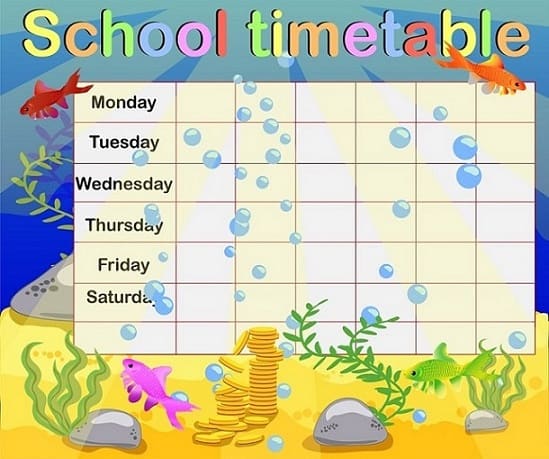Looking for an unbiased homeschool resource that doesn’t have a hidden agenda? You’ve come to the right place to learn how to homeschool in South Dakota.
To homeschool in South Dakota, a parent or guardian should become familiar with the state’s homeschooling laws and regulations. Families must decide on a curriculum that fits their needs and be prepared for the self-discipline required to maintain a robust academic schedule.

How to Homeschool in South Dakota
Homeschooling in South Dakota is regulated by the South Dakota Department of Education. Here are the steps you can follow to homeschool your child in South Dakota:
- Notify the South Dakota Department of Education (SDDOE) of your intention to homeschool. You can do this by submitting a Notice of Intent to Homeschool form to the SDDOE. This form must be submitted within 30 days of beginning to homeschool your child.
- Create a homeschool program for your child. Your homeschool program should include a plan for your child’s education, including the subjects you will teach and the materials you will use. You should also consider the needs of your child and how you will meet those needs through your homeschool program.
- Keep records of your child’s homeschooling progress. You should keep records of your child’s homeschooling progress, including attendance records, test scores, and other documentation of your child’s learning.
- Administer standardized tests. You are required to administer standardized tests to your child at least once every three years. You can choose to use a nationally recognized test or a test approved by the SDDOE.
- Submit an annual evaluation to the SDDOE. You are required to submit an annual evaluation to the SDDOE that includes a summary of your child’s homeschooling progress. This evaluation can be in the form of a portfolio of your child’s work or a report from a qualified evaluator.
Overall, homeschooling in South Dakota requires careful planning and organization, but it can be a rewarding and effective way to educate your child.

Free South Dakota Homeschool Programs
South Dakota provides various schooling options for homeschooling families, with a range of curriculum programs and free programs enabling students to receive instruction in an alternate atmosphere.
Regardless of money, these learning materials can be utilized to supplement or substitute regular schooling, offering kids academically-stimulating prospects.
If completed successfully, South Dakota’s free homeschooling programs will help students improve their academic performance and prepare them for higher education and beyond.
If you need more help homeschooling your child in South Dakota, check out the South Dakota Department of Education.
The Home School Legal Defense Association (HSLDA) is a valuable resource for South Dakota homeschoolers. They have laws, webinars, and articles about homeschooling to help parents.
Between 2019 to 2020, the percentage of homeschooled students changed from 3.4% to 9%.
Does Homeschool Have to be Accredited in South Dakota?
South Dakota does not require homeschooled students to be accredited. Instead, they must enroll in either a private school program or one that is authorized by the state’s Department of Education in order to be eligible for an alternative educational option outside of public school.
In South Dakota, accreditation is not mandatory for homeschooling programs, but the local school district has the power to decide which alternative education credits are eligible for transfer.
Hence, it’s imperative that any substitute learning plans comply with standards set by the respective district and necessary certification verification papers must be available when asked for.
67% of the homeschooled students successfully graduate from college.
South Dakota Accredited Homeschool Programs
To be an accredited homeschool, they must show proof of enrollment and attendance, keep grade records, give standard tests the state approves of, hire a supervising teacher with a high school diploma or equivalent, and be aware of all educational regulations changes.
Private schools that are accredited must declare their compliance with the laws and regulations of the state in their admission policies to meet the compulsory attendance requirements.
An accredited homeschool curriculum allows parents to provide quality education to their children in the comfort of their own homes.

Create a Designated Learning Place
Homeschoolers should have a specific area set aside for learning, to help establish a daily routine and provide an environment where their child can concentrate on schoolwork.
A dining table is an ideal spot for studying. It’s easily cleared off at the end of each day which allows it to be used for eating as well.
You can also provide your child with their own desk in their bedroom for added privacy and the opportunity to decorate it. Whatever you decide, be sure to create an environment that helps them focus on learning.
Over 300 million students were homeschooled as a result of the COVID-19 pandemic.
Stay On Track with a Daily Schedule
Sticking to a daily schedule for homeschooling has many advantages; here are some of them:
- Establishing a daily routine can help homeschoolers prioritize tasks, complete more in less time, and improve productivity. Families with multiple students or other outside commitments may particularly benefit from this strategy.
- Effective time management begins with planning. A daily schedule makes it easier to keep track of what needs to be done and when, and prevents feeling rushed or overwhelmed. Allocating specific blocks of time to tasks can help your family stay organized.
- Homeschooling can provide a sense of structure and regularity, especially beneficial for kids accustomed to attending a traditional school. This can make them feel safer and more prepared to learn.
- Families can benefit from daily schedules to stay accountable and meet their homeschooling objectives. This is important for those who tend to be easily distracted or delay their tasks.
- Having a daily schedule in place can facilitate better communication among family members, helping to avoid misunderstandings and building a stronger bond between them.

Ease Into It
Homeschooling for new parents can be a big shift, so it’s crucial to not apply excessive pressure from the start. It is best to ease into this transition and move forward at a steady pace.
Homeschooling parents can begin with just a few basic supplies and then build on their resources as they get more confident with the homeschooling process.
When it comes to homeschooling, there are numerous options, so you should find one that works best for your family. Don’t be afraid to venture out and experiment with different techniques; the less stressed you feel, the more successful your learning experience is likely to be.
Regardless of the educational level of their parents, homeschooled students score between 80% and 90%.
Involve Your Child in Setting Learning Goals
Involving your child in homeschool assignment planning and curriculum scheduling is important for several reasons:
- Offering students a sense of importance and ownership in their education will provide them with motivation and boost engagement.
- Involving them in the homeschool process will help them feel that they are part of it, rather than it being done to them.
- Getting your child involved in the homeschooling decision-making will give you a better understanding of their likes, talents, and shortcomings; allowing you to modify the learning environment to better accommodate them.
Generally, having your kid involved in homeschooling planning is key to a successful experience for everyone.

Explore Other Ways of Learning Outside the Classroom
Homeschooled kids have an advantage as they can explore many educational possibilities not found in a regular school. This helps them gain a diverse range of knowledge and experience, resulting in a more comprehensive education.
In many cases, homeschoolers benefit from strong connections in the community. These relationships can open doors to new learning opportunities, such as classes and workshops taught by experts or members of the community.
Parents who homeschool their children should seize these chances to broaden their kids’ education.
Homeschooling families can give their children a very enriching education by exploring different learning techniques.

Reach Out to Other Homeschool Families
Homeschooling can be difficult, especially for families without a support system. Luckily, there are various ways to make connections with other homeschoolers and build a community. One way is by connecting with local homeschooling organizations.
Homeschool groups can provide emotional support, practical advice from experienced homeschoolers, and opportunities for field trips and social interactions.
Joining an online forum or Facebook group is an excellent way to network with other homeschool parents.
Joining a parenting group can be helpful for exchanging resources, asking questions, and obtaining advice from parents who have the same experiences.
Making connections with other homeschooling families can help parents lessen the feeling of isolation and build a supportive environment for their kids.
When educated at home rather than in public schools, boys do 44% better on reading examinations.
Can Homeschooled Students Play Sports in South Dakota?
In South Dakota, homeschooled students can join in interscholastic activities if the school board approves.
South Dakota Legislature SDCL §13-36-7 allows any student enrolled in a home school program to join extracurricular activities sponsored by their district of residence.
Homeschooled students in South Dakota may have the opportunity to play high school sports if they meet the local school district’s requirements.
Homeschooled students can take advantage of this chance to participate in their local community and gain new abilities.

How to Homeschool When Both Parents Work
South Dakota parents who opt to homeschool their children have to be creative with balancing work and school, as it is a difficult task.
With some ingenuity, it’s possible to work and homeschool at the same time. Let’s examine some pointers to help you achieve it.
Prior to February 2020, just 68% of parents who had homeschooled their children said it had been a success.
Get Your Childcare Involved
Some parents are lucky enough to have assistance in homeschooling while they’re away at work due to childcare.
When it’s not achievable or budget-friendly for all households, one should think outside the box to devise a plan that fits everyone’s needs.

Delegate Chores
Involving your children in household tasks is an effective method to reduce the strain you may be facing between work and homeschooling. It also provides them with an opportunity to learn about responsibility.
It’s prudent to be mindful of your child’s abilities. A five-year-old probably won’t be able to do the laundry, but they can lend a hand with things like dusting or laying the table.
As they age, give your children more chores. By involving them in household tasks, you can reduce your work while teaching them essential life skills.
Before the epidemic, 69% of homeschooled children expressed a desire to continue their studies in this manner for the upcoming school year.
You and Your Spouse Work Alternate Shifts
Balancing homeschooling with both parents working can be difficult, especially if you and your partner have alternating shifts. Here are some strategies to help make it work:
- It’s important to organize your week in advance by creating a schedule that includes all of your work hours and other responsibilities. This will help you plan effectively for homeschooling.
- Make use of online materials: Utilizing online components like lesson plans, videos, and virtual excursions can be a great way to supplement your kid’s schooling when you are not able to be with them in person.
- Be flexible with your homeschooling: If your daytime commitments don’t make 9 to 3 schooling feasible, think outside the box. For instance, you can do lessons at night or at the weekend. Or, break up the day into shorter chunks of time for educational activities.
- Ask for assistance: Don’t be scared to look for support when you need it. This could involve employing a tutor or nanny to aid with home-based instruction while you are busy, or requesting the aid of relatives and friends.
- Homeschoolers should be aware that it’s okay to take breaks. Finding a balance between work and homeschooling will help ensure that commitments are met on both fronts.
Homeschooling can be a tricky task if both parents are working. But it can be done with the right amount of planning and creativity, making it an enriching experience for the whole family.

Take Advantage of Online Curriculums
Homeschooling is a great option to personalize your child’s education, yet it can be difficult to fit work and school into one schedule. To make it easier, why not opt for an online curriculum?
Structured learning programs can assist your child in their development and ensure concentration while you are away.
Furthermore, online learning can be tailored to your child’s individual requirements, making it convenient to discover a course that suits their distinctive learning approach.
In their children’s upcoming academic year, 54% of parents who were homeschooling before February 2020 were likely to do so full-time.
Assign the Child Solo Activities to Do While You’re at Work
Parents in South Dakota who teach their kids at home must find ways to keep their children entertained while they are working. One way is to assign independent curriculum projects.
Tasks such as reading assignments, research projects, and math and writing exercises may be included.
It’s essential to select activities that are suitable for your child’s age and skill level.
If your child attends childcare, ask your provider to remind them to complete their homeschooling tasks daily.
Proper planning can help your child become independent and accomplish tough tasks during the workday.

Allow Yourself Flexibility and Grace
Balancing a job and homeschooling can be difficult for parents, so it’s vital to give yourself some leniency and kindness while managing these duties.
Striving for perfection is an unattainable goal that can lead to disappointment. Focus on the successes, no matter how small, and congratulate yourself on your achievements.
Keep in mind that your kids are observing you, and will take after you. By displaying a positive outlook and openness to change, they’ll be more likely to do the same.
Balancing work and homeschooling can be difficult, but it also presents an excellent opportunity to impart valuable lessons to your children. Show them how to be adaptable and graceful in any situation, setting them up for victory down the line.
The typical cost of homeschooling is between $350-$750 per year for the parent(s).
South Dakota Homeschool Curriculum Requirements
In South Dakota, when homeschooling, parents are allowed to select their own curriculum; however, the state does require instruction in subjects such as:
- Reading
- Writing
- Math
- Science
- Social studies
- Physical education
Homeschooling gives families lots of options to tailor their kids’ education. They can focus on topics they’re passionate about or teaching styles that suit them best.
By designing their own curriculum, parents can ensure their child’s education fits the personal needs of each student. This makes homeschooling in South Dakota an effective educational option.

Letter of Intent to Homeschool in South Dakota
The South Dakota Department of Education requires all parents who wish to homeschool their children to submit a Letter of Intent.
Submitted to the local school district, this document serves as formal notification that the family will be responsible for providing home education.
The Letter of Intent must list the names, addresses, and birthdates of all homeschooled children along with the name and address of the parent/guardian providing their education.
Furthermore, the letter must include an outline of the curriculum.
Submitting a Letter of Intent may not be complicated, but it is necessary to make sure homeschooled families abide by state regulations.
The federal government saves $24 billion in taxpayer money thanks to homeschooling.
Is the South Dakota Homeschool Curriculum Free?
More South Dakotan families are choosing to homeschool their children for various reasons, though the cost of a curriculum can be a major issue. Fortunately, free curricula and resources can be found online.
An easy online search will uncover many websites that provide free homeschooling materials such as lesson plans, worksheets, and full curriculums.
Homeschooling families can often find discounts or free memberships available from educational organizations.
It is possible to efficiently and affordably homeschool your children with a bit of dedication.

How Much Does It Cost to Homeschool in South Dakota?
Homeschooling in South Dakota may involve joining a pre-existing organization, which comes with fees or exploring other options that have varying costs.
Some people choose to buy a curriculum from an online store or local shop. Depending on the grade and topics included, curriculum costs can range from a few hundred to several thousand dollars.
Furthermore, some families opt to enlist the help of a tutor or take online classes, which come at an additional cost. Compared to private school tuition, homeschooling in South Dakota is usually more cost-effective.
Considering the potential costs is an essential part of deciding whether to homeschool.
A safe environment was cited as the main motivation by 50% of parents who homeschool their children.
How Many Days Are Required for Homeschool in South Dakota?
The state of South Dakota has put in place attendance requirements. For Kindergarten students, 437 hours of instruction are required each year. For students in grades 1-5, 875 hours of instruction are required. And for students in grades 6-12, 962 hours of instruction are required.
These requirements ensure that homeschooled students receive a well-rounded education and have opportunities to interact with their peers.
Families who choose to homeschool their children can rest assured that their children will receive a quality education that meets all state standards.

South Dakota Homeschool Record Keeping
One of the most important requirements for homeschooling in South Dakota is keeping records. State law requires that homeschooling parents maintain records of their child’s educational progress. These records can include things like attendance, coursework, and standardized test scores.
While it may seem like a lot of work to keep track of all this information, it is essential for ensuring that your child is receiving a quality education.
These records can be helpful in demonstrating your child’s progress to friends and family members who may be skeptical of homeschooling.
In short, Record keeping is an important part of homeschooling in South Dakota and should not be overlooked.
Here are some things that are important to keep a record of during the homeschooling years:
- Test results
- Samples of your student’s academic work
- Documentation of the type of curriculum being provided to your child
- Dialog with state and/or school officials
- Attendance records
A good rule of thumb is to save these records for at least two years or longer if required.
Therefore, it is essential for homeschoolers in South Dakota to keep careful records of their educational activities.
Test results, extracurricular activities, and socialization were mentioned as reasons for homeschooling by 14% of the parents.
South Dakota Homeschool Diploma
For homeschooled students in South Dakota, earning a diploma can be an even greater accomplishment. Homeschooled kids don’t have the structure of a regular school schedule, so they have to be self-motivated and disciplined to do well. A high school diploma is a symbol of hard work and dedication.
Earning a diploma shows that they have what it takes to set goals and achieve them.
In addition, a diploma for South Dakota homeschoolers can open up new opportunities, such as colleges and scholarships.
For homeschooled students, a high school diploma is an important milestone on the road to success.

How Does a Homeschooled Student Get a Diploma?
Parents in South Dakota who homeschool their children have the unique opportunity to be the sole provider of their child’s high school diploma. This means that they get to decide what criteria must be met in order for their child to earn the diploma.
Of course, parents will want to ensure that their child meets all the necessary requirements for graduation, such as taking required courses and passing exams.
However, they also have the freedom to tailor the curriculum to their child’s interests and learning style.
As a result, homeschooled students often emerge with a well-rounded education that prepares them well for success in college and beyond.
Before COVID-19, 42% of parents said they wished their kids had more freedom to pursue their hobbies.
Are Homeschool Diplomas Valid?
The homeschooling movement has been growing steadily recently, as more parents opt to educate their children at home. While homeschooling can provide a number of benefits, there is one potential drawback: homeschool diplomas may not be as recognized by colleges or employers.
Some institutions may require additional testing or coursework for homeschooled students, so students should be prepared to take some tests to show their level of academics.
It’s not uncommon at all for homeschooled kids to be more academically advanced than their peers who attended a public school, so in the long run, homeschoolers are quite capable of holding the advantage.
However, it is important to note that homeschool diplomas are becoming increasingly common and should be accepted by most colleges and employers.
As of February 2020, at least 9 million Americans had been homeschooled at least once.
Disclaimer
Although the information in this article was researched with the utmost integrity and sincerity, it cannot be held legally liable or expected to take the place of legitimate legal advice for your specific situation.

Trina Greenfield, Author
SmackDown Media LLC
LinkedIn
About the Author:
Trina Greenfield, the owner of SmackDown Media LLC, is passionate about providing information to those considering their educational options. Trina is a seasoned writer, content creator, and website owner with a passion for unbiased research, educational platforms for children and adults, as well as all things family-related.